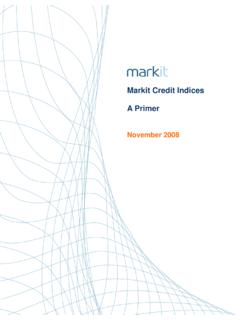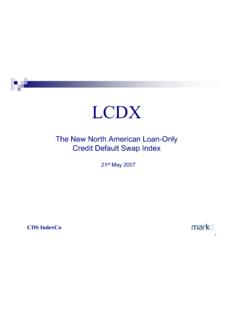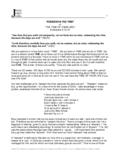Transcription of Talking Business Man on the spot - IHS Markit Home Page
1 /6 Talking Businessthe Markit magazine Summer 08 Man on the spotPhoto: Stephen SullivanTalking Business /7 Summer 08 the Markit magazineQ What does Christofferson, Robb & Company (CRC) do?A Our core Business is investing in asset-backed securities and private structured credit transactions that help European banks transfer risk and improve their balance sheets or their return on regulatory capital. Working with a single buyer, terms can be fine-tuned to meet the issuer s are not traders or arbitrageurs but, rather, buy-and-hold investors. Underneath it all are old-fashioned assets: small and medium enterprise loans, prime residential mortgages, commercial leases or other loans on a bank s balance sheet. Q How did you start up a fund like that?A We were not a fancy start-up. In October 2002, Johan Christofferson and I launched with $11m under New York, we sub-let an office and part of a hallway across from Bloomingdale s.
2 In London, we had a mews house near Earls Court. Our IT head, Oleg Gokhman, financed the computers on his personal credit card. As soon as we launched, we registered with the US SEC, which requires $25m under management within 90 days. We didn t think that would be a problem, but it turned out that it visited about 100 investors in Europe and the US to explain the opportunities in European structured credit. Many were surprised to learn that Europe had a structured credit market at all. At best, investors would say: You will be a safer investment at $50m than $11m. You will be more diversified and have better access to financing. I will take you from $50m to $70m. Richard Robb talks about his Business a hedge fund that invests in structured credit and wind energy teaching at Columbia University and his views on crises past and presentR sum 1981 BA Economics: Duke University 1985 PhD Economics: University of Chicago 1985 1992: The Chicago Corporation bond sales and trading 1992 2001: The Dai-Ichi Kango Bank head of global derivatives and securities businesses (NY, London, Hong Kong) 2001 present: professor of professional practice in international finance, Columbia University s School of International & Public Affairs 2002 present: ceo, Christofferson, Robb & Company/8 Talking Businessthe Markit magazine Summer 08So there were two stable equilibria: a good one and a bad one.
3 Given that no-one wanted to invest, no-one else wanted to invest. Given that everyone else wanted to invest, the others were happy to come in. We were stuck in the bad equilibrium. Looking back on it, the mews house probably didn t the darkest moment, we faced the embarrassing prospect of de-registering from the SEC because our 90 days had lapsed and we were still too small. Our original investor was making noises about getting their money the SEC kindly gave us a one-month extension. Luckily, a new investor swooped in with $40m in the nick of time. Other investors fell into place, and here we are the first year, we grew to a dozen employees in New York and London. Only a few of the junior employees who needed money to live were able to take the end of 2003, we had about $100m. We realised we had crossed a certain threshold when we began buying napkins from the store rather than stealing paper towels from the building s men s have grown in spurts since 2003 as opportunities arose.
4 During most of 2006 and the first half of 2007, we were closed to new investment because the portfolio threw off cash about as fast as we could invest it. Lately we have found more opportunity and we have been able to increase the size of our How much do you manage?A We say it s a secret, but anyone can go to the NASD s website to see assets under management for a registered fund. Our credit fund s NAV is about $ and we now also have a wind energy fund that accounts for slightly less than half that amount Structured credit funds have suffered huge losses during the credit crisis why hasn t CRC?A That s FAQ #1 these days. I have my response ready to go. I ll give you the medium-length version. There is no short version, because it s not a simple fund, but maybe this will be interesting to your readers and give some insight into our all of the fund s deals follow a simple formula: (i) a European bank originates assets in the normal course of its Business with an intent to retain the assets on its balance sheet; (ii) the bank then determines that it can reduce regulatory capital requirements or improve its financial statements by transferring a portion of the risk to an end investor.
5 (iii) the bank and CRC work directly to optimise the benefits to the bank while incorporating structural protections that are important to this approach to sourcing deals is not a sufficient condition for stable returns for the fund, it goes part of the way towards insulating us from end-of-cycle products sold by financial intermediaries (such as sub-prime originators or leveraged loan CLO managers) that compete for the same assets and package them to appeal to used to say the fund was built to withstand turmoil like 1998 an expression that seems quaint today. Structurally, the fund was resilient during the crisis due to light leverage and term are only leveraged times ($1 of capital supports $ in assets) and approximately 93% of the fund s on-balance-sheet funding is in a term structured repo that matures in 2012. The fund s small amount of short-term repo proved to be , our stable investor base has been key.
6 CRC has taken care to assemble a diversified, sophisticated investor base that would stay cool during market strains. Our precautions paid off during the crisis, since investors redeemed a total of only $35m in the second half of 2007, which is equivalent to about one month s free cash flow.[For more on this see box on page 12]Q How did you get involved in wind energy?A In 2005 we started looking at a securitisation of loans to wind farms as we felt it was a good fit with CRC s traditional Business . We decided that the money to be made at the time, at least in onshore wind, was through owning the farms, not lending to was an opportunity for a roll-up that would buy a scale portfolio and benefit from efficiencies in operating, maintenance and financing. Once the wind farms are constructed, returns largely depend on how hard the wind blows, producing a return stream that would be highly valued by CRC s investors.
7 We bought our first onshore German wind farm within the credit fund in July 2005 so that we could learn about how they worked. In the worst case, we were confident we could sell it in a year if we changed our minds about wind. By the spring of 2006, we had acquired 300 megawatts in 29 farms throughout Germany and repaid our construction debt by issuing a whole Business securitisation called CRC Breeze Finance that HVB underwrote. CRC Breeze issued 300m of senior notes rated triple-B by S&P and Fitch and 50m of junior notes rated double-B plus. According to Windpower Monthly, it was the first time the international capital markets had been tapped to finance renewable German and French markets lend themselves naturally to securitisation because the grid operator has to buy all the power we can produce at a feed-in tariff that is guaranteed for 20 years.
8 In short, the wind farms of CRC Breeze convert the kinetic energy of the wind to electricity; the grid operator pays a fixed price; the SPV uses the money to pay interest and principal on the rated /10 Talking Businessthe Markit magazine Summer 08markets are in equilibrium, and market participants rationally anticipate information that they acquire after engaging in optimal search. But early in my time at Columbia, Ned Phelps, a profoundly original thinker, opened me up to his own work and that of the great Chicago economist, Frank Knight. I have come to accept that ambiguity surrounds a great deal of decision-making by consumers, new businesses and established businesses. They cannot be meaningfully characterised as maximisation problems subject to fully-specified probability distributions. Two books I can recommend on the subject are Imperfect Knowledge Economics published last year by Roman Frydman and Michael Goldberg, and The Venturesome Economy forthcoming by Amar Bhid in September fits with the role I see for hedge funds: hedge funds exist to cope with risks that are, in Richard Zeckhauser s terminology, unknown and unknowable.
9 Our prospects for excess returns arise precisely because we are encounter-ing novel conditions and allow a small number of senior traders to apply heavy amounts of level of individual discretion would not be possi-ble at a big bank for instance, DKB could not delegate authority to apply common sense to individuals. A big bank needs process. Senior management can t possibly monitor the calibre of judgment if it lets 50,000 employees act as they put it another way, at CRC we seek to be what Friedrich Hayek called a man on the spot , who possesses local and transitory knowledge of circumstances that cannot be easily translated into fixed rules. Our approach hinges on applying the knowledge of a man on the spot alongside quantitative techniques and empirical analysis. In this way we guard against applying historical analysis that has become outdated or misses important features of the deal we are considering.
10 Q You had a front row seat for the Asian/LTCM crisis working for a Japanese bank. How is the current crisis different?A The last crisis was also unnerving and, by objective measures, so far just as severe. I never expected Nippon Credit, Long Term Credit Bank, Hokkaido Takushoku Bank and Yamaichi Securities to fail. This crisis differs from 1998 not just in degree. We have had 10 years for quantitative structured finance, with the full co-operation of the rating agencies, to metastasise. As rating agencies pushed models further and further, the world s most conservative money market investors ended up holding ABCP that hinged on bizarre, simplistic models. These models lack empirical or theoretical content. The longer the boom lasted, the more rating agencies and debt; and the equity holder receives the distributions left You sold the Breeze farms on.


